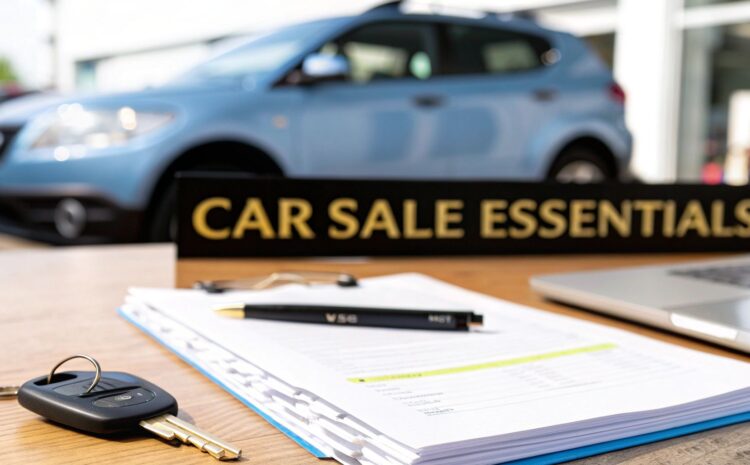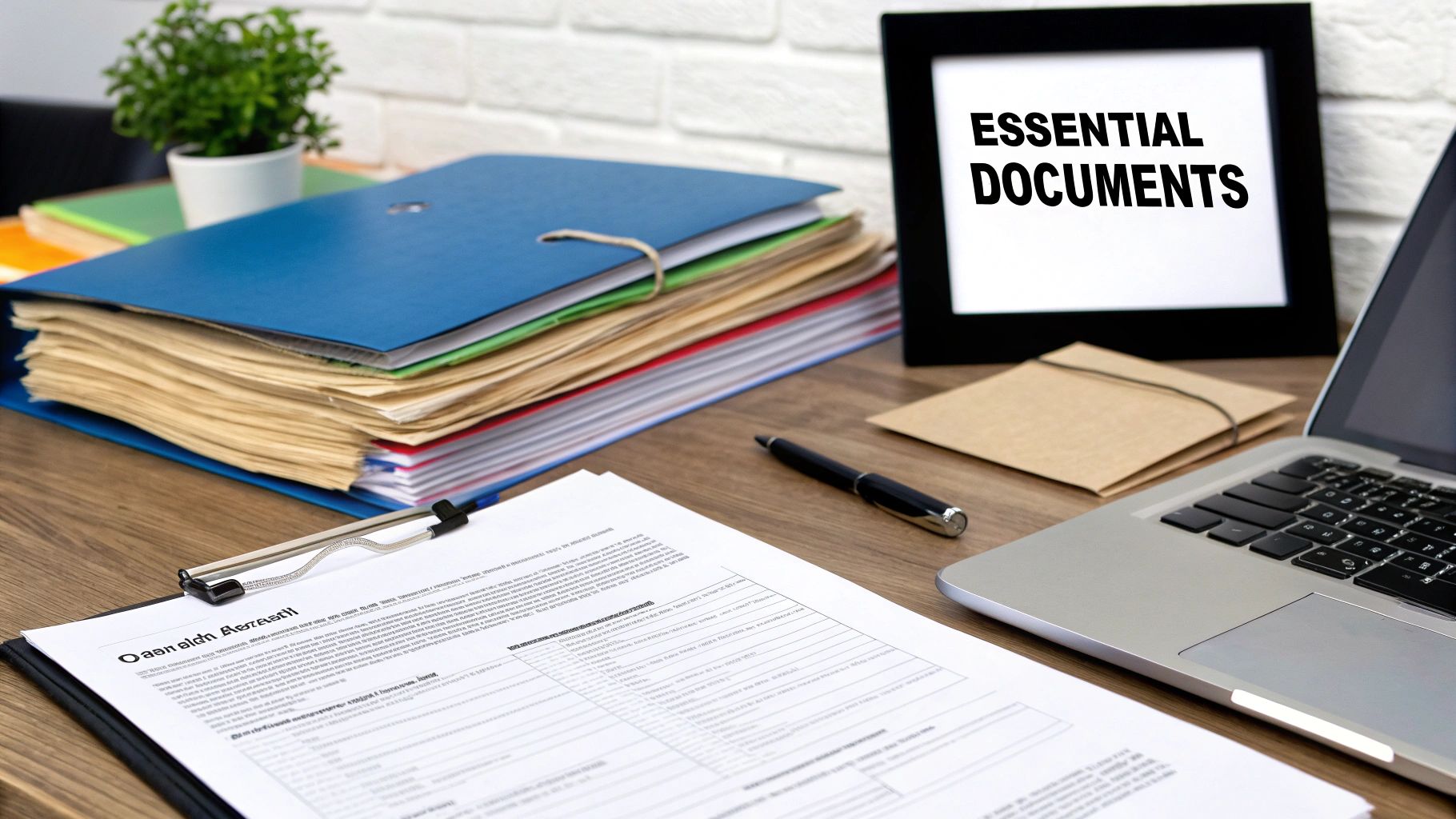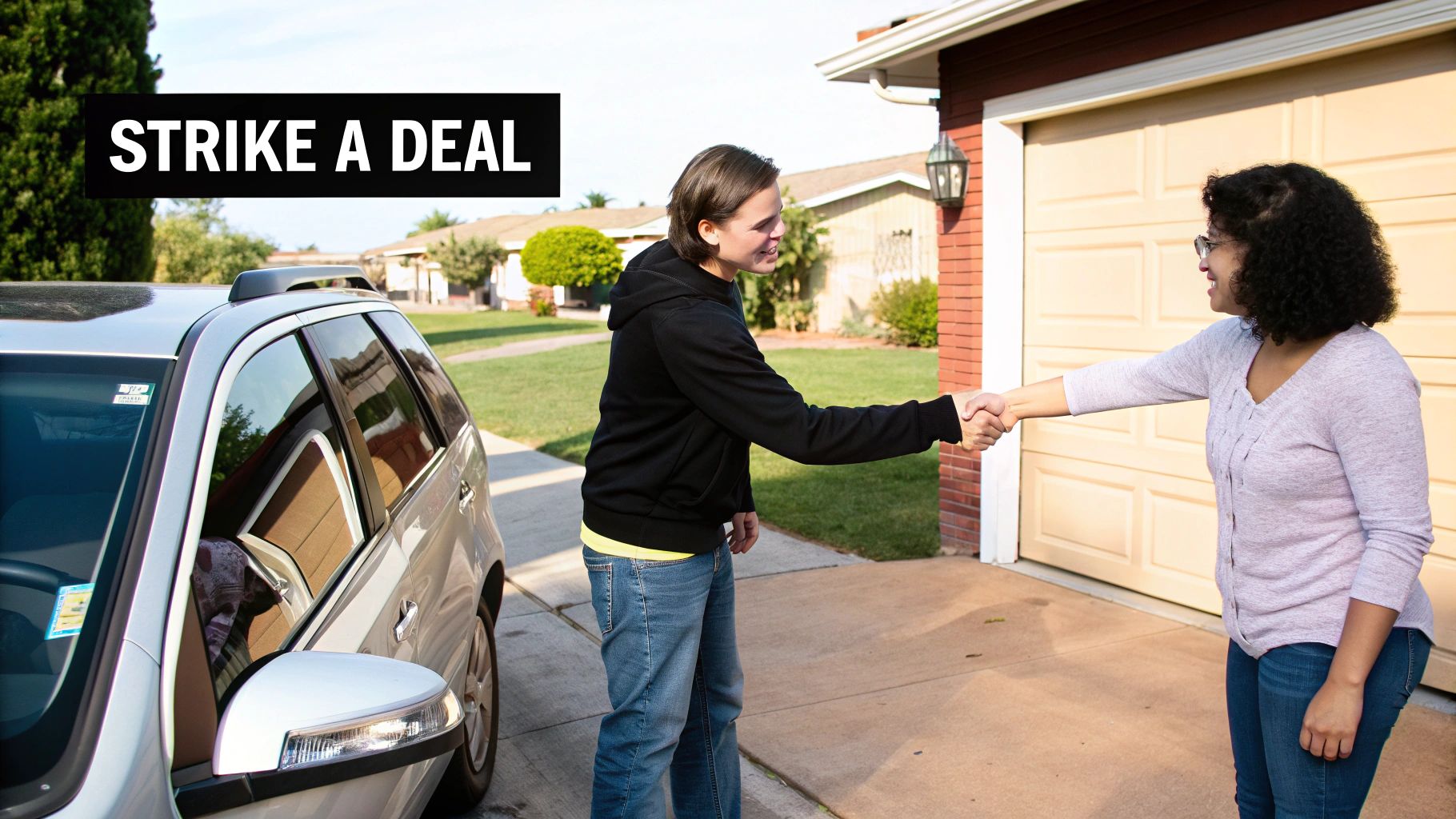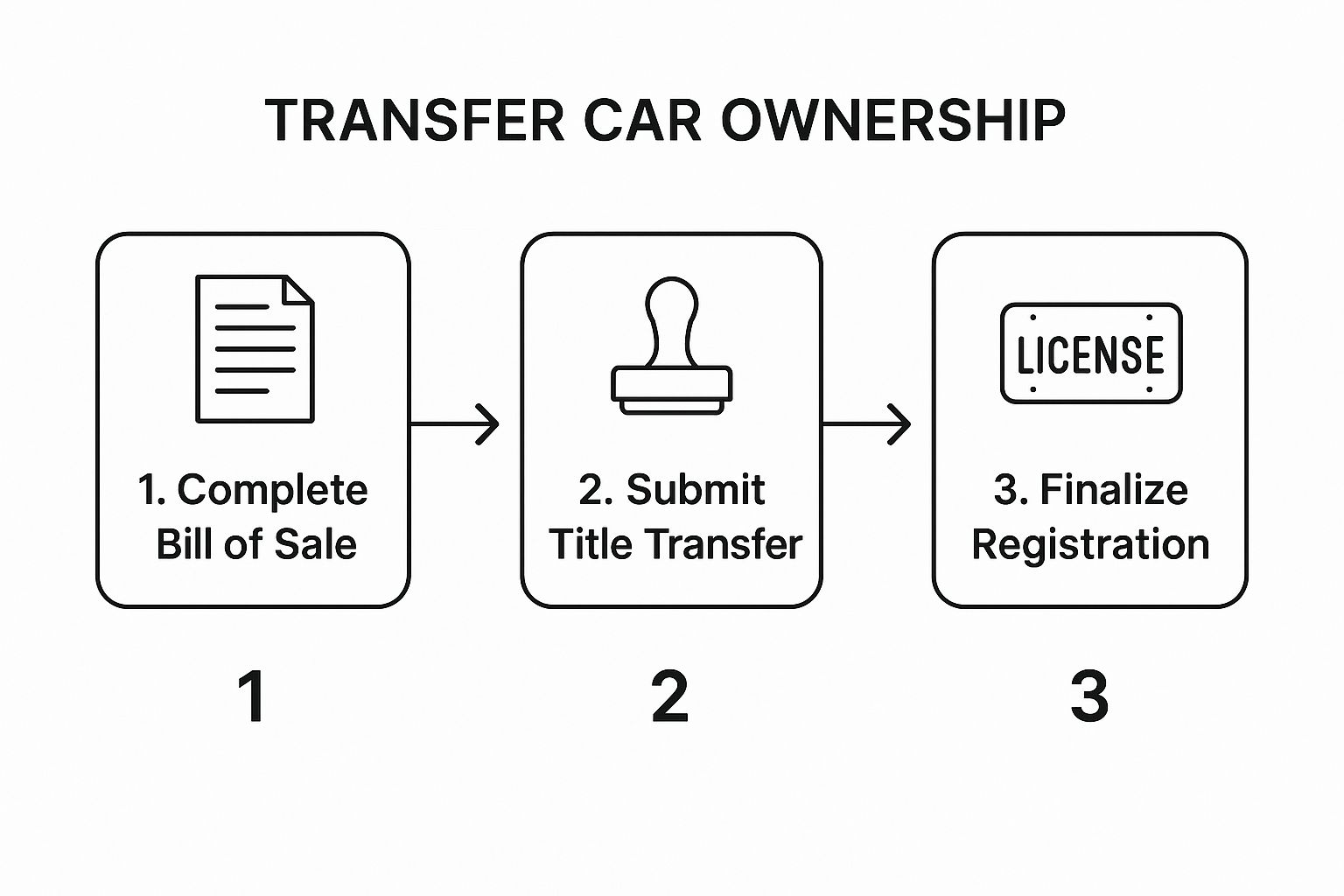
What Do You Need When Selling a Car in the UK? Essential Tips
When you're ready to sell your car, a few key documents are absolutely essential. Think of them as your car's passport. You'll need the V5C logbook, a valid MOT certificate (if the car is over three years old), and any service history you've kept. Getting this paperwork in order before you do anything else will make the whole process a lot smoother and help build trust with anyone who comes to view it.
Getting Your Paperwork in Order

Before you even dream of writing that perfect advert, your first job is a bit of admin. Pulling together all the necessary documents is the foundation of a clean, legal sale. It doesn't just speed things up; it's the number one way to show a potential buyer you’re a genuine and organised seller.
The V5C Logbook: Proof of Ownership
First things first, find your V5C registration certificate – what most of us just call the logbook. This is the non-negotiable, single most important document. It's the official DVLA paper that proves the car is legally yours to sell.
Honestly, trying to sell a car without the V5C is a massive red flag for any clued-up buyer and can grind the whole process to a halt. Before you list the car, dig out the V5C and check that all the details are spot on, especially your name and address. You'll need the 11-digit document reference number from it to tell the DVLA online when you’ve sold it.
The MOT Certificate: A Legal Must-Have
In the UK, any car over three years old legally needs a valid MOT to be on the road. This isn't optional. When you sell, the buyer will expect a current, valid certificate.
A car with a long MOT is a fantastic selling point. Even better is a clean history with few or no advisories. It gives buyers immediate peace of mind, assuring them the vehicle is roadworthy and has been looked after.
Expert Insight: A complete and well-organised service history can genuinely increase your car's value. From my experience, showing a buyer a folder brimming with receipts and a valid MOT not only builds instant trust but can often boost the final sale price by up to 10%.
Service History: Your Car's Biography
While it's not a legal requirement like the V5C or MOT, a full service history can make a world of difference to your car’s appeal and asking price. This could be a pristine, main-dealer-stamped service book or simply a folder packed with invoices and receipts from your trusted local garage.
This paperwork tells the story of your car’s life. It shows it has been cared for, detailing everything from regular oil changes to more significant repairs. It’s what justifies your price and helps your car stand out from the crowd. Having these documents ready is critical; being unprepared can cause delays and even penalties. You can discover more about how crucial good documentation is from recent industry reports.
To make sure you have everything you need, here’s a quick-reference checklist of the crucial documents for a legal and successful car sale in the UK.
Essential Documents Checklist for Selling Your Car
| Document | Why It's Essential | Top Tip |
|---|---|---|
| V5C Logbook | This is your legal proof of ownership. No V5C, no sale. It's that simple. | Make sure your name and address are correct before showing it to buyers. Keep it safe! |
| Current MOT Certificate | A legal requirement for cars over 3 years old. It proves the car is roadworthy. | A long MOT (6+ months) is a great selling point. A clean history with no advisories is even better. |
| Full Service History | Builds buyer confidence and can significantly increase your car's resale value. | Organise all receipts and stamps chronologically in a folder. It looks professional and shows you’ve cared for the car. |
| Owner's Manual | Contains vital information about the car's features and maintenance schedules. | Buyers appreciate having the original manual. Keep it in the glove box so you don't forget it. |
Having these items organised and ready to present will make you look like a professional, trustworthy seller and ensure the entire handover is as smooth as possible.
Right, with your paperwork sorted, let's get to the fun part: making your car look its absolute best. It’s no secret that first impressions count for a lot, and a car that looks sharp instantly feels like it's been well looked after. This bit is all about justifying your asking price before you’ve even shaken hands.
Getting It Showroom-Ready
A quick trip through the car wash isn't going to cut it here. We're talking about a proper, deep clean. While a professional valet is a great option if you're short on time, you can get fantastic results yourself with a bit of elbow grease.
Don’t just wash the paintwork. Get into the details that buyers notice, even subconsciously. Clean out the wheel arches, polish the glass until it’s streak-free (inside and out!), and apply some dressing to the tyres and black plastic trim. It’s these little touches that make a car pop.
The inside is just as crucial. Pull out the mats, vacuum everywhere—and I mean everywhere—including under the seats and deep into the boot. If you've got stains on the seats, now’s the time to tackle them. And please, get rid of any old smells from pets, food, or smoke. A proper odour-neutralising spray is your best friend here; it eliminates smells, whereas a simple air freshener just masks them. A fresh, clean interior screams "well-cared-for car."
Smart Repairs and Standout Photos
Now, take a good look at the car's exterior. You need to be smart about what you choose to fix. This is a balancing act between spending a little to make a lot more.
- Things worth fixing: Minor scuffs on the alloy wheels, annoying stone chips, and small paint scratches. These are usually cheap and easy jobs for a mobile repair specialist, but they can make a massive difference to how the car presents.
- Things to leave alone: Don’t bother with major dents or serious mechanical faults. You likely won't get your money back on big repairs. It's far better to be upfront and honest about these issues with potential buyers. Transparency builds trust.
Once your car is gleaming, it’s time for its photoshoot. Good photos are your single most powerful tool for attracting genuine interest online. Forget a quick snap on your phone in the dark. Wait for a bright, overcast day to avoid harsh shadows and reflections.
Use the best camera you have and take plenty of pictures. Get shots from every angle, close-ups of each wheel, the dashboard (showing the mileage), a wide shot of the interior, and even a clean engine bay. More photos mean fewer questions and more serious buyers.
One last, vital job: Before anyone comes to see the car, do a digital cleanse. Unpair your phone from the Bluetooth system and wipe any and all personal data. That means clearing saved home or work addresses from the sat-nav. It protects your privacy and gives the new owner a completely clean slate.
How to Price Your Car Competitively

Nailing the price is probably the most critical part of selling your car. Get it right, and you’ll have buyers lining up. Get it wrong, and you’ll be hearing crickets for months.
While those instant online valuation tools are a decent place to start, think of them as a rough guide, not a definitive price tag. They give you a ballpark figure, but the real magic happens when you roll up your sleeves and do a bit of your own market research.
I always recommend spending some quality time on the big UK car sites like Auto Trader, Gumtree, and Motors.co.uk. Your goal is to find cars that are the same make, model, and year as yours. This is your competition.
Analyse Competing Listings
Once you've found a handful of similar cars, it’s time to get forensic. The devil is in the details, and these are the factors that will either add or subtract pounds from your asking price:
- Mileage: How does your car's mileage stack up? If you’ve got significantly fewer miles on the clock, don't be shy about asking for a bit more. It's a major selling point.
- Specification: Trim levels are a huge deal. A 'Titanium' spec Ford Focus is a world away from a basic 'Style' model. The same goes for an 'M Sport' BMW versus a standard SE. Make sure you’re comparing apples with apples.
- Condition: Now for a moment of honesty. Take a good, hard look at your car. Every scuff, scratch, and kerbed alloy wheel affects the value. Price it fairly based on its real condition, not the condition you wish it was in. Even cars with serious damage have a market; for more on that, check out our tips on how to sell a salvage car successfully.
- Location: Believe it or not, where you live matters. A car for sale in central London might be priced differently from the exact same model in Manchester. Scope out local listings to get a feel for your area’s going rate.
Use Pricing Psychology and Timing
There are a few old-school tricks that still work wonders. Pricing your car at £7,995 instead of a flat £8,000 is a classic for a reason. To a buyer’s brain, it just feels like a much better deal, even though it's only a fiver's difference.
Key Takeaway: Pricing isn't just a numbers game; it's about strategy and timing. A little market awareness can make a massive difference to how quickly you sell and for how much.
Timing is another massive factor. Want a quick sale? Research suggests that pricing your vehicle 5-10% below the market average can help it sell up to 25% faster. The used car market also has seasons. Prices often dip between July and December, so if you can wait, you might get more for your motor. You can find more details on UK automotive sales figures to get a better sense of these trends. Armed with this knowledge, you can set a price that gets your phone ringing straight away.
Creating an Advert That Attracts Buyers

Even the most immaculate car will get overlooked if the advert is a dud. After you've got the car gleaming and your paperwork sorted, the next hurdle is crafting a listing that turns casual scrollers into genuinely interested buyers. This all comes down to writing an honest, compelling description and picking the right place to post it.
The real secret to a great advert? Detail. Don't just tick the boxes; tell the car's story. Be completely upfront about its condition, the mileage on the clock, and its full specification. A serious buyer knows what they need when selling a car, and they'll appreciate you making it easy for them.
Think of a well-written advert as your first line of defence. Providing loads of detail and brilliant photos helps to filter out the time-wasters, attracting knowledgeable people who value transparency from the get-go.
Crafting a Compelling Description
When you write the description, think about what a buyer wants to see first. Structure it clearly so they can quickly scan for the most important bits.
- The Essentials: Kick things off with the make, model, year, mileage, engine size, and whether it’s petrol or diesel. Get this right at the top.
- Service History: This is a huge selling point. State clearly if it has a full or partial service history. Something like, "Full service history with stamped book and a thick folder of receipts," works wonders.
- Recent Work: Have you spent money on it recently? Shout about it! "New clutch fitted 3,000 miles ago" or "Four new tyres last year" builds confidence and justifies your asking price.
- Honesty Is the Best Policy: Be straight about any known faults or cosmetic blemishes. A small scratch is better mentioned upfront. It builds trust and saves everyone from a wasted trip.
Here in the UK, you've got a few solid platforms to choose from. Auto Trader is generally where serious buyers head, often willing to pay a fair price for the right car. For a wider, more local reach, places like Gumtree and social media marketplaces are good options, but be prepared for more casual enquiries and a bit of haggling.
Staying Safe During Viewings and Test Drives
Once the messages start rolling in, it's time to switch to a safety-first mindset. It's always a good idea to have a quick phone call with a potential buyer rather than just sticking to texts. It helps you get a better feel for them.
For the viewing itself, arrange it at your home during daylight hours. If you can, have a friend or family member around. When the conversation turns to a test drive, you must remain in control.
Always go with them on the drive—never, ever let a stranger drive your car off alone. Before they even get behind the wheel, ask to see their driving licence and proof that their insurance covers them to drive other cars. Most fully comprehensive policies do, but it’s on them to prove it. This simple step is non-negotiable; it protects you and your car.
Finalising the Sale Legally and Securely
You’ve found a buyer and settled on a price. Excellent. Now comes the most critical part: the handover. Getting this stage right is all about protecting yourself from any future trouble. Think of it as your final check to ensure a clean break with no loose ends.
Create a "Sold as Seen" Receipt
First things first, get a receipt sorted. It doesn't have to be a fancy legal document, but a simple, clear receipt is non-negotiable. I always recommend writing "Sold as Seen, Tried, and Tested" on it.
This little phrase is your best friend. It helps protect you if the buyer comes back later with a problem. Your receipt should include:
- The car's make, model, and registration number
- The date of sale and the final price paid
- The full names and addresses of both you and the buyer
Make sure you both sign it, and you each keep a copy. Simple.
Get Your Money Safely
When it comes to payment, you can't be too careful. Cash might seem tempting, but handling thousands of pounds in notes is risky and difficult to verify. For peace of mind, a UK bank transfer using the Faster Payments Service is easily the safest and quickest option.
My Golden Rule: Never, ever hand over the keys, the car, or the V5C logbook until you have personally logged into your own bank account—on your own phone or computer—and seen the money sitting there. Don't fall for a screenshot or an email confirmation from the buyer; these can be easily faked.
Notifying the DVLA The Right Way
Once the funds have cleared and you're happy, you need to tell the DVLA you've sold the vehicle immediately. This isn't something to put off until later.
The best way to do this is online, right there with the buyer. You'll need the 11-digit reference number from the little green 'new keeper' slip (the V5C/2 section) of your V5C logbook.

The online process is instant. You’ll get an email confirming the transfer of ownership, which officially ends your responsibility for the car. Any road tax refund you're owed will also be triggered automatically. Doing this correctly means you're no longer liable for any future parking tickets, speeding fines, or tax issues. The buyer is now the registered keeper and can legally drive away.
If you had previously declared the car off the road, our guide on how to SORN your vehicle has some useful information you might need.
Common Questions About Selling a Car
When you're getting close to selling your car, a few specific questions always seem to pop up. Getting these details right from the start is the key to a smooth transaction, helping you avoid any last-minute hitches or awkward legal grey areas.
Tax, Payment, and Finance Queries
A big one is always about the car tax. Let's be clear: in the UK, vehicle tax is non-transferable. You can't sell a car with tax on it. The moment you tell the DVLA you've sold the car, they'll automatically process a refund for any full months you have left. The new owner is then entirely responsible for taxing the vehicle before they drive it an inch.
Then there's the money. How do you get paid safely? The best and most secure method by far is a verified bank transfer through the Faster Payments Service. The key word here is verified. Don't just take the buyer's word for it or accept a screenshot as proof. Log into your own online banking app and see the funds sitting in your account before you even think about handing over the keys. Cash might seem simple, but it's risky to handle large amounts, and personal cheques are just too easy to cancel.
What if the car still has outstanding finance? Transparency is everything. Your first step is to call your finance company and ask for a "settlement figure". This is the final, exact amount required to clear the loan. This debt must be cleared either before or at the moment of sale. A common, and reassuring, way to handle this is to have the buyer transfer the funds, and then you pay off the settlement figure online while they are still with you. It’s a clean process that gives everyone peace of mind.
Dealing with a Lost V5C Logbook
Misplacing your V5C logbook can feel like a major roadblock, but it’s a surprisingly common and fixable issue. You can apply for a duplicate directly from the DVLA, either online or by post. It costs £25, and you can usually expect the new document to arrive within five working days.
My advice? Always wait for the replacement V5C to arrive before you finalise the sale. Trying to sell without it can make buyers wary and seriously complicates the legal ownership transfer, which is a crucial part of what you need when selling a car.
For more answers to common queries, you can review our detailed car selling FAQ page for further guidance.
If your car has reached the end of its life and a private sale isn't an option, Fast Scrap Car offers a swift, reliable, and transparent solution for scrapping your vehicle across London, Surrey, Essex, Kent, Sussex, and Hertfordshire. Get a competitive quote and enjoy a hassle-free process with same-day collection and instant payment. Find out more at https://fastscrapcar.co.uk.
